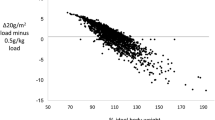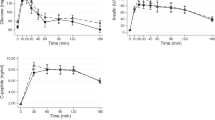Abstract
Objectives:
To analyze whether a decreased sensitivity to adrenaline in women with earlier gestational diabetes (GDM) explains the impairment in the thermogenic response to food (=post-prandial thermogenesis (PPT)) that is observed in these women at future risk of obesity and type II diabetes.
Subjects/Methods:
Ten normal-weight women with previous GDM and 10 controls matched for body weight, all with normal glucose tolerance, had insulin sensitivity, PPT and the thermogenic response to an adrenaline infusion measured.
Results:
Insulin sensitivity was similar in the previous GDM compared with control groups: (mean±s.e.m.) 29.1±3.2 vs 30.9±1.6 mg/l/min. The early (0–30 min) PPT response was diminished and delayed in women with previous GDM compared with controls: (10±2 vs 15±1 kJ, P=0.04); time constant for PPT (median (interquartile range)) (57 (47–79) vs 29 (25–49) min, P=0.01). The overall PPT response and the thermogenic response to adrenaline were not significantly different between the groups. The 30 min and 2 h PPT response correlated positively and significantly with the increment in energy expenditure as a result of the adrenaline infusion (ρ=+0.65; P=0.04 and ρ=+0.71; P=0.02, respectively) in women with previous GDM only. There was no correlation between adrenaline and insulin sensitivity.
Conclusions:
There is no evidence of diminished adrenaline sensitivity but a positive relationship exists between PPT and sensitivity to adrenaline in women with previous GDM. The mechanism is not mediated through insulin resistance. This relationship may predispose these normal-weight at-risk women to future weight gain.
This is a preview of subscription content, access via your institution
Access options
Subscribe to this journal
Receive 12 print issues and online access
$259.00 per year
only $21.58 per issue
Buy this article
- Purchase on Springer Link
- Instant access to full article PDF
Prices may be subject to local taxes which are calculated during checkout

Similar content being viewed by others
References
Alberti KG, Daly ME, Robinson A, Marshall SM, Mathers JC (1999). The short insulin tolerance test is safe and reproducible. Diabet Med 16, 352–353.
Anyaoku VJ, Johnston DG (1995). Rapid specific and sensitive enzyme linked immunosorbent assay for intact insulin. Diabetalogia 38 (Suppl A), 157.
Astrup A, Andersen T, Henriksen O, Christensen NJ, Bulow J, Madsen J et al. (1987). Impaired glucose-induced thermogenesis in skeletal muscle in obesity. The role of the sympathoadrenal system. Int J Obes 11, 51–66.
Astrup A, Simonsen L, Bulow J, Madsen J, Christensen NJ (1989). Epinephrine mediates facultative carbohydrate-induced thermogenesis in human skeletal muscle. Am J Physiol 257, E340–E345.
Astrup A, Simonsen L, Christensen NJ (1990). Effects of beta-adrenergic blockade on meal-induced thermogenesis. Clin Physiol 10, 305–307.
Beck V, Jaburek M, Demina T, Rupprecht A, Porter RK, Jezek P et al. (2007). Polyunsaturated fatty acids activate human uncoupling proteins 1 and 2 in planar lipid bilayers. FASEB J 21, 1137–1144.
Camastra S, Bonora E, Del Prato S, Rett K, Weck M, Ferrannini E (1999). Effect of obesity and insulin resistance on resting and glucose-induced thermogenesis in man. EGIR (European Group for the Study of Insulin Resistance). Int J Obes Relat Metab Disord 23, 1307–1313.
Chokkalingam K, Jewell K, Norton L, Littlewood J, van Loon LJ, Mansell P et al. (2007). High-fat/low-carbohydrate diet reduces insulin-stimulated carbohydrate oxidation but stimulates nonoxidative glucose disposal in humans: an important role for skeletal muscle pyruvate dehydrogenase kinase 4. J Clin Endocrinol Metab 92, 284–292.
DeFronzo RA, Thorin D, Felber JP, Simonson DC, Thiebaud D, Jequier E et al. (1984). Effect of beta and alpha adrenergic blockade on glucose-induced thermogenesis in man. J Clin Invest 73, 633–639.
Del Prato S, Marchetti P, Bonadonna RC (2002). Phasic insulin release and metabolic regulation in type 2 diabetes. Diabetes 51 (Suppl 1), S109–S116.
Dornhorst A, Chan SP, Gelding SV, Nicholls JS, Baynes C, Elkeles RS et al. (1992). Ethnic differences in insulin secretion in women at risk of future diabetes. Diabet Med 9, 258–262.
Ek I, Arner P, Bergqvist A, Carlstrom K, Wahrenberg H (1997). Impaired adipocyte lipolysis in nonobese women with the polycystic ovary syndrome: a possible link to insulin resistance? J Clin Endocrinol Metab 82, 1147–1153.
Engfeldt P, Hellmer J, Wahrenberg H, Arner P (1988). Effects of insulin on adrenoceptor binding and the rate of catecholamine-induced lipolysis in isolated human fat cells. J Biol Chem 263, 15553–15560.
Felber JP, Thiebaud D, Maeder E, Jequier E, Hendler R, DeFronzo RA (1983). Effect of somatostatin-induced insulinopenia on glucose oxidation in man. Diabetologia 25, 325–330.
Fellows IW, Bennett T, MacDonald IA (1985). The effect of adrenaline upon cardiovascular and metabolic functions in man. Clin Sci (Lond) 69, 215–222.
Festa A, Krugluger W, Shnawa N, Hopmeier P, Haffner SM, Schernthaner G (1999). Trp64Arg polymorphism of the beta3-adrenergic receptor gene in pregnancy: association with mild gestational diabetes mellitus. J Clin Endocrinol Metab 84, 1695–1699.
Flatt JP (1978). The biochemistry of energy expenditure. In: Bray GA (ed) Recent advances in obesity research. Newman: London. pp, 211–228.
Forbes S, Moonan M, Robinson S, Anyaoku V, Patterson M, Murphy KG et al. (2005). Impaired circulating glucagon-like peptide-1 response to oral glucose in women with previous gestational diabetes. Clin Endocrinol (Oxf) 62, 51–55.
Forbes S, Robinson S, Dungu J, Anyaoku V, Bannister P, Forster D et al. (2006). Sustained endogenous glucose production, diminished lipolysis and non-esterified fatty acid appearance and oxidation in non-obese women at high risk of type 2 diabetes. Eur J Endocrinol 155, 469–476.
Forster CD, Macdonald IA (1999). The assay of the catecholamine content of small volumes of human plasma. Biomed Chromatogr 13, 209–215.
Franssila-Kallunki A (1992). Comparison of near-infrared light spectroscopy, bioelectrical impedance and tritiated water techniques for the measurement of fat-free mass in humans. Scand J Clin Lab Invest 52, 879–885.
Frayn KN (1983). Calculation of substrate oxidation rates in vivo from gaseous exchange. J Appl Physiol 55, 628–634.
Himms-Hagen J (1990). Brown adipose tissue. In: Bray GA, Bouchard C, James WP (eds). Handbook of Obesity. Marcel Dekker, Inc.: New York.
Illingworth PJ, Jung RT, Howie PW, Isles TE (1987). Reduction in postprandial energy expenditure during pregnancy. Br Med J (Clin Res Ed) 294, 1573–1576.
Jequier E, Acheson K, Schutz Y (1987). Assessment of energy expenditure and fuel utilization in man. Annu Rev Nutr 7, 187–208.
Kousta E, Parker KH, Lawrence NJ, Penny A, Millauer BA, Anyaoku V et al. (2002). Delayed metabolic and thermogenic response to a mixed meal in normoglycemic European women with previous gestational diabetes. J Clin Endocrinol Metab 87, 3407–3412.
Lee YS, Shin S, Shigihara T, Hahm E, Liu MJ, Han J et al. (2007). Glucagon-like peptide-1 gene therapy in obese diabetic mice results in long-term cure of diabetes by improving insulin sensitivity and reducing hepatic gluconeogenesis. Diabetes 56, 1671–1679.
Macdonald IA, Bennett T, Fellows IW (1985). Catecholamines and the control of metabolism in man. Clin Sci (Lond) 68, 613–619.
Metzger BE, Cho NH, Roston SM, Radvany R (1993). Prepregnancy weight and antepartum insulin secretion predict glucose tolerance five years after gestational diabetes mellitus. Diabetes Care 16, 1598–1605.
Newsholme EA (1980). Sounding Board. A possible metabolic basis for the control of body weight. N Engl J Med 302, 400–405.
O′Sullivan JB (1982). Body weight and subsequent diabetes mellitus. JAMA 248, 949–952.
Ravussin E, Acheson KJ, Vernet O, Danforth E, Jequier E (1985a). Evidence that insulin resistance is responsible for the decreased thermic effect of glucose in human obesity. J Clin Invest 76, 1268–1273.
Ravussin E, Bogardus C, Schwartz RS, Robbins DC, Wolfe RR, Horton ES et al. (1985b). Glucose-induced thermogenesis and insulin resistance in man. Int J Obes 9 (Suppl 2), 103–109.
Ravussin E, Lillioja S, Anderson TE, Christin L, Bogardus C (1986). Determinants of 24-h energy expenditure in man. Methods and results using a respiratory chamber. J Clin Invest 78, 1568–1578.
Robinson S, Chan SP, Spacey S, Anyaoku V, Johnston DG, Franks S (1992). Postprandial thermogenesis is reduced in polycystic ovary syndrome and is associated with increased insulin resistance. Clin Endocrinol (Oxf) 36, 537–543.
Robinson S, Johnston DG (1995). Advantage of diabetes? Nature 375, 640.
Robinson S, Niththyananthan R, Anyaoku V, Elkeles RS, Beard RW, Johnston DG (1994). Reduced postprandial energy expenditure in women predisposed to type 2 diabetes. Diabet Med 11, 545–550.
Ryan EA, Imes S, Liu D, McManus R, Finegood DT, Polonsky KS, Sturis J (1995). Defects in insulin secretion and action in women with a history of gestational diabetes. Diabetes 44, 506–512.
Segal KR, Albu J, Chun A, Edano A, Legaspi B, Pi-Sunyer FX (1992). Independent effects of obesity and insulin resistance on postprandial thermogenesis in men. J Clin Invest 89, 824–833.
Segal KR, Lacayanga I, Dunaif A, Gutin B, Pi-Sunyer FX (1989). Impact of body fat mass and percent fat on metabolic rate and thermogenesis in men. Am J Physiol 256, E573–E579.
Tataranni PA, Christin L, Snitker S, Paolisso G, Ravussin E (1998). Pima Indian males have lower beta-adrenergic sensitivity than Caucasian males. J Clin Endocrinol Metab 83, 1260–1263.
Weicko JS, Sherman WR (1976). Boroacetylation of carbohydrates. Correlation between structure and mass spectral behaviour in monoacetyl hexose cyclic boronic esters. Journal of the American Chemical Society 98, 7631–7637.
WHO (1999). Definition, Diagnosis and Classification of Diabetes Mellitus and its Complications. Report of a WHO consultation.
Wolfe RR (1992). Radioactive and stable isotope tracers in biomedicine: Principles and Practice of Kinetic Analysis. A John Wiley and Sons, Inc, Publication: Wiley-Liss.
Acknowledgements
Fellowships supporting the grant: SF was supported by a Novo Nordisk UK Fellowship, charity number 1056410 and Diabetes UK charity number 215199. Build-Up was kindly provided by Nestle.
Author information
Authors and Affiliations
Corresponding author
Rights and permissions
About this article
Cite this article
Forbes, S., Robinson, S., Parker, K. et al. The thermic response to food is related to sensitivity to adrenaline in a group at risk for the development of type II diabetes. Eur J Clin Nutr 63, 1360–1367 (2009). https://doi.org/10.1038/ejcn.2009.91
Received:
Revised:
Accepted:
Published:
Issue Date:
DOI: https://doi.org/10.1038/ejcn.2009.91



